After the fall of the Caliphate of Córdoba, 39 small states were created that occupied the territory that had covered the lands of the Caliph. These small states have gone down in history under the name of “taifas”. And without a doubt one of the most important taifas that existed due to its duration in time, political power and cultural boiling was the Taifa of Zaragoza. In the following blog article, we will review the history of this Muslim kingdom.
History of The Taifa of Zaragoza
The capital of the Upper March. Antecedent of the Taifa of Zaragoza.
After the Muslim conquest of Zaragoza in 714, this city became one of the most important of those located in the north of Al Ándalus. Saraqusta was the capital of the Upper March, one of the 3 administrative divisions of Al-Andalus.
Saraqusta was far from Córdoba, the capital of Al-Andalus. Therefore, it is not surprising that, from the first years after the Islamic conquest, the governors of this city yearned to get rid of the political ties that united them to Córdoba.

As I explained in the article on “Muslim Zaragoza”, the first moment of tension between Saraqusta and the Andalusian central power occurred in the middle of the 8th century, when the Vali of Córdoba tried to impose a Syrian governor on Saraqusta. This took a toll on the Yemeni elite that had been predominant in the Ebro Valley since the conquest. In 714 the Saraqusts of Yemeni origin organized a rebellion in the city against the new governor elected from Córdoba.
On one occasion, the Yemeni elite from the cities of Zaragoza, Barcelona and Huesca even negotiated an alliance that resulted in “The siege of Charlemagne’s Saraqusta in 778”.
There were also conflicts in the 9th century. During this time, the powerful Banu Qasi family from Muladí had become lords of the Ebro Valley. They became related to the royal family of Pamplona and sought to break away on various occasions from the political ties that linked them to the Emirate of Córdoba through rebellions.
However, the Banu Qasi did not achieve their objectives and at the end of the 9th century the Banu Tuyib replaced them as the most powerful clan in the Ebro Valley. This family of Yemeni origin, having initially settled in Daroca, expanded their area of influence to Calatayud. and finally, protected by Córdoba, they carried out the coup, becoming governors of Saraqusta in 890. We know who was the first Tujibi governor of Saraqusta, his name was Muhammad Al-Anqar.
During the time of the Caliphate of Córdoba (929-1031), the Tuyibí governors remained in power.
The fall of the Caliphate of Cordoba
Before addressing the history of the Saraqusta Taifa, it is convenient to address what happened to the Cordovan caliphate in its last years of existence.
It turns out that during the reign of Hisham II (976 – 1009) his chamberlain Almanzor seized the political power that was associated with the position of caliph, turning the caliph into a mere puppet. Almanzor annihilated all the rivals of the caliphal court, leaving a huge power vacuum when he died in 1002.
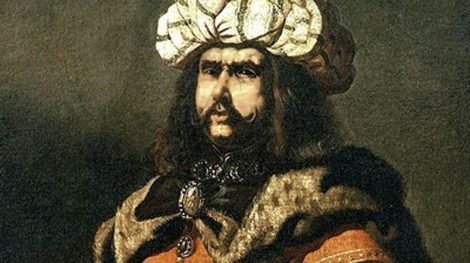
Said power vacuum was tried to be filled by the children of Almanzor. Said sons were Abd al-Málik al-Muzáffar and Abderramán Sanchuelo. After trying to position Sanchuelo as the caliph’s heir, a rebellion broke out that ended with his assassination and the overthrow of Hisham II.
After this rebellion came others and a dozen descendants of Abd al-Rahman III proclaimed themselves caliphs without being able to consolidate themselves on the throne. Finally, in 1031 the powerful of Córdoba decided to put an end to the Caliphate and would create a council of notables that would govern the city for the following years.
Taifa of Zaragoza under the Banu Tuyib (1018 – 1046)
Given the chaos that ensued in Córdoba, the Tujibi ruler of the city Mundir I, who had gained much of a reputation fighting in Almanzor’s army, severed his political ties to Córdoba in 1018. Mundir I minted currency for the Muslim state that you just created. These coins appear inscriptions dedicated to the “hayib”.
“Háyib” was the position with which the taifa kings of Saraqusta were entitled. This position, although originally it would come to mean something like “chamberlain”, since Almanzor used it, it had acquired a more prestigious connotation even than that of the title that would come to mean king in Arabic, which was “malik”.
The new independent kingdom initially included the current province of Zaragoza and various towns that are currently part of other provinces such as Soria, Medinaceli, Calahorra, Arnedo, Alfaro and Lleida.
The Tujibids did not have a very long run as independent kings of Saraqusta. The last Tujib, Abd Allah Ibn Hákam, was not very loved in the city because he had come to power after assassinating his cousin Mundir II. The discontent of the saraqustíes against this last tujibí was taken advantage of by the taifa governor of Lleida Sulaymán ibn Hud al-Musta’in who convinced the saraqustíes so that they made him the master of him. This is how the Banu Hud family came to power in Saraqusta in 1046.
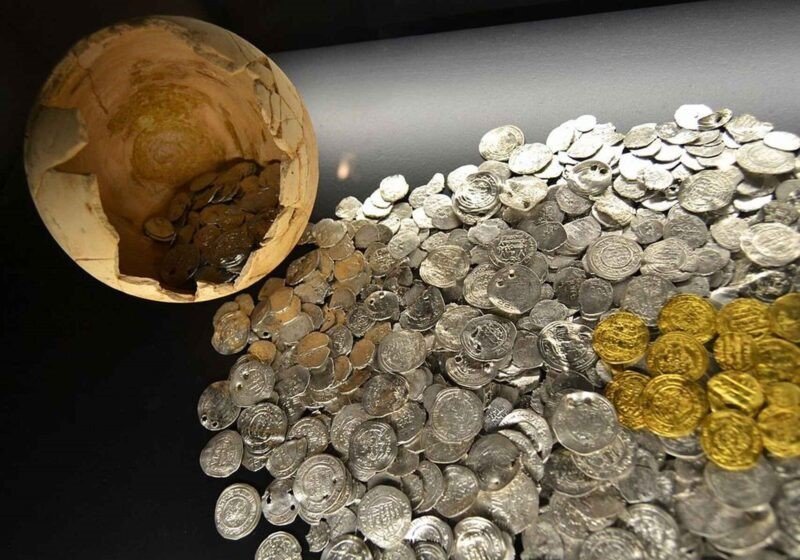
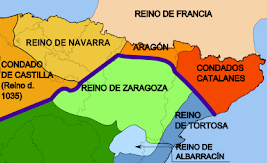
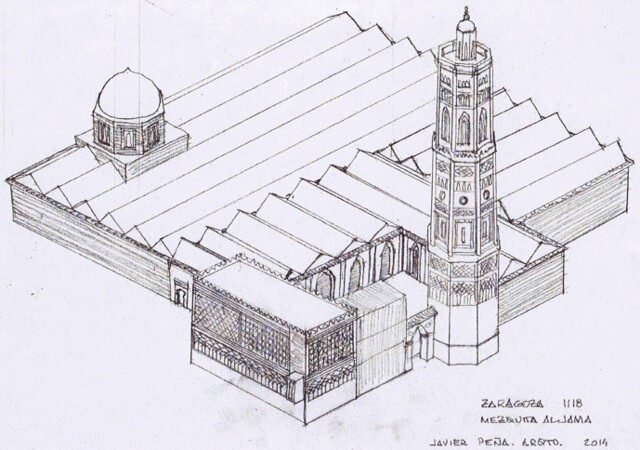
Taifa of Zaragoza under the Banu Hud (1046 – 1110)
El reinado de al-Muqtádir en la Taifa de Zaragoza (1046 – 1081)
Sulaymán’s successor was Abu Jáfar al-Muqtádir. Al-Muqtádir reigned between 1046 and 1081. His accession to the throne initially meant the loss of Lleida which his brother al-Múzzafar inherited. Al Muqtádir conquered Tortosa and Denia and subjected Valencia to vassalage. Consequently, the kingdom of Saraqusta included, in addition to the Ebro Valley, the Levante coast.
In 1064 Pope Alexander II called to take the Muslim city of Barbastro. This appeal will be the first crusade in history (before Jerusalem). The Aragonese, in collaboration with Christian armies that came from Catalonia, France and Italy, seized Barbastro from al-Muzzáfar, who was the brother of al-Muqtádir and king of the taifa of Lérida.
In response, al-Muqtádir launched a jihad to recover Barbastro in which Muslims from all over Al-Andalus participated. The victory of the taifa king of Saraqusta earned him the nickname “al-Muqtádir bi-L lah” (powerful thanks to Allah).
During the reign of Abu Yáfar al-Muqtádir, the splendid Aljafería palace was built. The name of the Aljafería itself comes from Jáfar, the middle name of al-Muqtádir. From Jáfar would come “al-jafariya” and from “al-jafariya” it went to Aljafería.
In the Aljafería, great scholars of the thriving Andalusian cultural world met. Among these wise men was the philosopher Avempace, who introduced Aristotle to Arabic philosophy.
In 1079 al-Muqtadir managed to defeat his brother Al-Muzzáfar and reintegrate Lleida in Saraqusta. Such reintegration would be short-lived. And it is that after Al-Muqtádir died, two of his sons shared his kingdom. Al Mutaman stayed with Saraqusta and Al Mundir with Lleida and Levante.
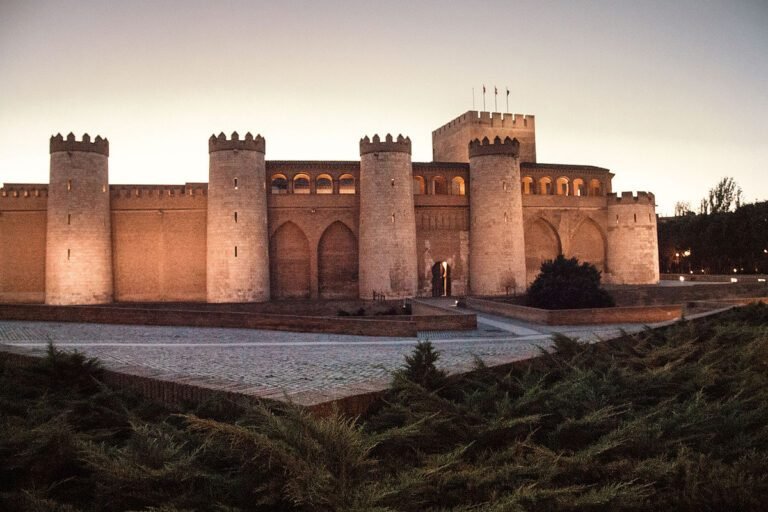

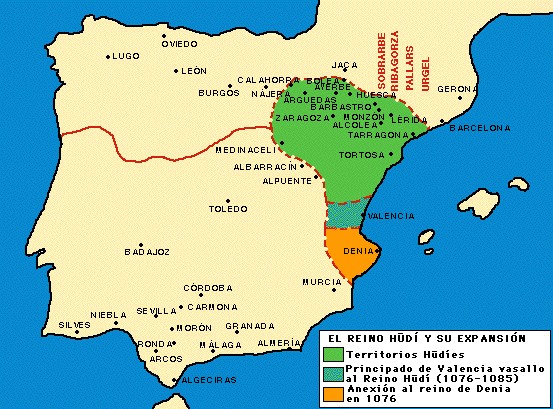
The reign of Al Mutaman in the Taifa of Zaragoza (1081 – 1085)
Al Mutaman seemed to have been given a poisoned candy. All the lords whose territory bordered Saraqusta allied to attack Al Mutaman. Among these enemies of Saraqusta was King Sancho Ramírez of Aragón, Count Berenguer Ramón II of Barcelona and his own brother, the Taifa king of Lérida Al-Mundir. However, the intelligent Al Mutaman hired Rodrigo Diaz de Vivar, “El Cid”, the greatest warrior of his time.
The Saraqusti troops and the retinues of El Cid were able to defeat the coalition of Aragonese, Catalans and Muslims led in the battle of Almenar in 1082. In this battle the Count of Barcelona was taken prisoner and surely released after paying a large sum of money.
During the reign of Al Mutaman there was also a conspiracy against him. His uncle Al Muzzáfar, who was imprisoned in Rueda de Jalón, conspired by promising Alfonso VI King of León this town in exchange for him overthrowing Al Mutaman and granting him the taifa of Saraqusta.
When Alfonso VI arrived in Rueda, Al Muzzáfar had died. The governor of Rueda, who was initially implicated in the plot, decided to repel the Leonese army from the fortress with arrows, killing important Christian noblemen. Rodrigo Díaz de Vivar had to go to Rueda to mediate with Alfonso VI. Finally, Alfonso VI withdrew.
Al Mutaman, like his father, surrounded himself in the Aljafería with wise men. He was also an expert in philosophy, astrology and mathematics.
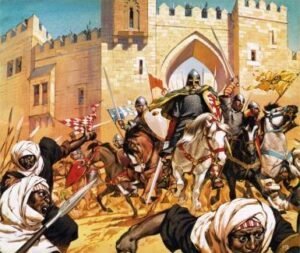

The end of the Taifa of Zaragoza (1085 – 1110)
Territorial extension during the taifa of Zaragoza Shortly after the death of Al Mutaman, the Cid left the court of Saraqusta. There were two more kings in the taifa of Saraqusta. They were called Al-Mustain II and Abdelmálik.
Al-Mústain II was able to achieve the survival of the taifa by paying tributes to the kingdom of León to protect him against the Almoravids. This taifa king died in the battle of Valtierra on January 24, 1110 against Alfonso I.
Abdelmálik, on the other hand, could not contain the pro-Almoravid faction that had been created in the kingdom. This faction hated the fact that the taifa could only survive by giving money to the Christians. The pro-Almoravids collaborated with the Almoravids to overthrow Abdelmálik in May 1110 and integrate Saraqusta into the Almoravid Empire.
In the battle of Alcoraz in 1096, Pedro I of Aragon conquered Huesca. Finally, in 1110 the Almoravids took over the Aljafería, putting an end to the independent taifa of Saraqusta. 8 years later Alfonso I “el Batallador” conquered Zaragoza, putting an end to the Muslim government of the city.
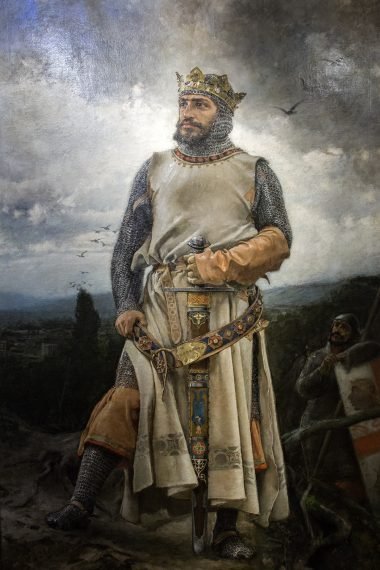
Biogrophical sources
Fras, M. J. C. (1999). El Reino de Saraqusta. Caja de Ahorros de la Inmaculada.
F. (2021, 7 agosto). Dos dinares de oro aclaran sobre la «fitna de al-Ándalus». FUNCI – Fundación de Cultura Islámica. https://funci.org/dos-dinares-de-oro-arrojan-nueva-luz-sobre-la-fitna-de-al-andalus/

